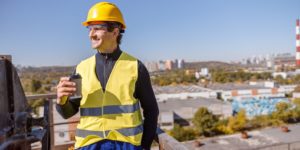Automated Laser Cladding for 3D Metal Additive Repair
Optomec integrates Fanuc LRMate 200 robotic loading with its Huffman line of production 3D metal additive repair machines for high-volume turbine work and myriad industrial applications. Autonomous batch processing expedites cycle times and frees the operator to add value elsewhere.
Posted: May 27, 2020
Optomec (Albuquerque, NM) offers integrated robotic automation for its Huffman line of production 3D metal additive repair machines. The solution combines Optomec’s Huffman line of production laser cladders together with a Fanuc LRMate 200, a compact, six-axis industrial robot with the approximate size and reach of a human arm.
This robotic integration automates the loading and unloading of parts into the chuck of the laser cladder, allowing the system to operate at even faster cycle times by working from trays and racks that contain a dozen or more components. Though the automation scheme is especially suited for high volume repair of turbine blades and vanes, it can be applied to a number of industrial applications such as the repair of sealing surfaces of diesel engine components, or the addition of hardfacing materials to industrial valve parts.
“Before automated laser cladding, the workflow for turbine blade repair was long and complicated. Optomec optimized the flow dramatically by combining vision systems, software and laser cladding into one hardened, production-grade process step,” says Todd Lorich, engineering manager for Optomec’s Huffman line of automated laser cladders. “Now we are taking it one step further. Adding robotic part handling inside the machine really completes the automation for the process, freeing up the operator to add more value elsewhere in the workflow.”
Optomec is certified for aviation repair in 15 countries, and its Huffman brand laser cladders have remanufactured more than 10 million turbine components over the last 15 years.
Optomec’s 3D metal additive systems use directed energy deposition (DED) – a form of metal 3D printing that enables highly repeatable repairs of high value components and delivers superior metallurgy at a lower cost compared to hand TIG-welded repairs.
The combination of the Huffman line of laser cladders with the Fanuc LRMate 200 and Optomec’s AutoCLAD vision and adaptive process software together make automated laser cladding suitable for high volume, high-accuracy, high-acceleration applications.















